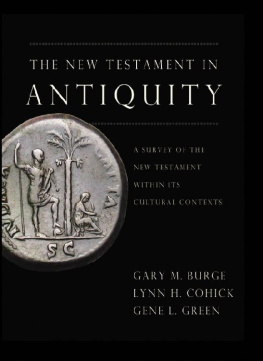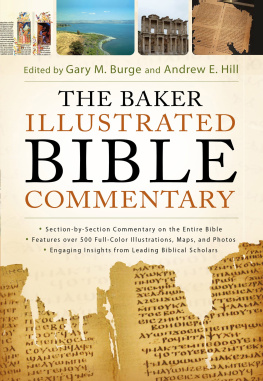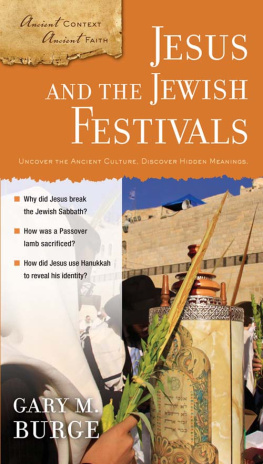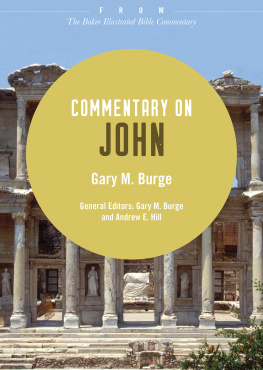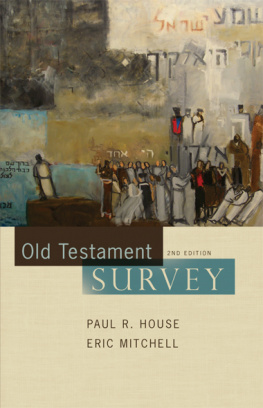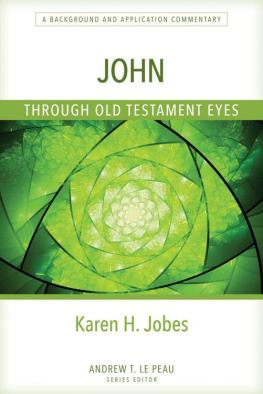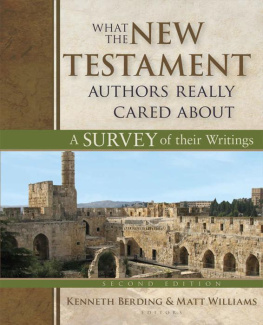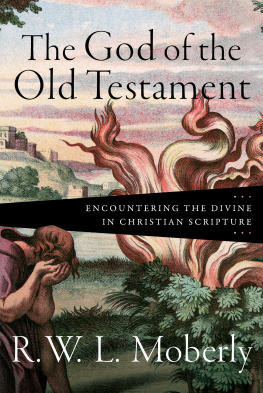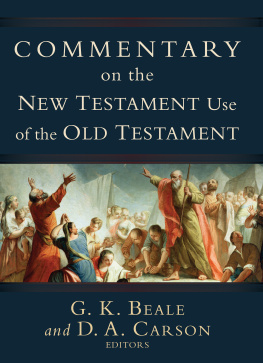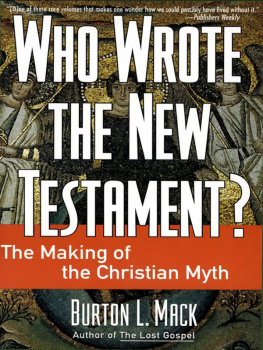ZONDERVAN
THE NEW TESTAMENT IN ANTIQUITY
Copyright 2009 by Gary M. Burge, Lynn H. Cohick, and Gene L. Green
All rights reserved under International and Pan-American Copyright Conventions. By payment of the required fees, you have been granted the non-exclusive, non-transferable right to access and read the text of this e-book on-screen. No part of this text may be reproduced, transmitted, down-loaded, decompiled, reverse engineered, or stored in or introduced into any information storage and retrieval system, in any form or by any means, whether electronic or mechanical, now known or hereinafter invented, without the express written permission of Zondervan.
ePub Edition February 2017: ISBN 978-0-310-59061-3
Requests for information should be addressed to:
Zondervan, Grand Rapids, Michigan 49530
Library of Congress Cataloging-in-Publication Data
Burge, Gary M., 1952
The New Testament in antiquity / Gary M. Burge, Lynn H. Cohick, and Gene L. Green.
p. cm.
Includes bibliographical references and index.
ISBN 978-0-310-24495-0
1. Bible. N. T. Textbooks. 2. Bible. N.T. Antiquities. I. Green, Gene L. II. Cohick, Lynn H. III. Title.
BS2535.3.B87 2007
225.61 dc22
2006026524
All Scripture quotations, unless otherwise indicated, are taken from the Holy Bible, Todays New International VersionTM. TNIV. Copyright 2001, 2005 by International Bible Society. Used by permission of Zondervan. All rights reserved.
Any Internet addresses (websites, blogs, etc.) and telephone numbers printed in this book are offered as a resource. They are not intended in any way to be or imply an endorsement by Zondervan, nor does Zondervan vouch for the content of these sites and numbers for the life of this book.
All rights reserved. No part of this publication may be reproduced, stored in a retrieval system, or transmitted in any form or by any means electronic, mechanical, photocopy, recording, or any other except for brief quotations in printed reviews, without the prior permission of the publisher.
Maps by International Mapping
09 10 11 12 13 14 15 16 17 18 19 20 23 22 21 20 19 18 17 16 15 14 13 12 11 10 9 8 7 6 5 4 3 2
Information about External Hyperlinks in this ebook
Please note that footnotes in this ebook may contain hyperlinks to external websites as part of bibliographic citations. These hyperlinks have not been activated by the publisher, who cannot verify the accuracy of these links beyond the date of publication.
To our many students
who continue to inspire us
CONTENTS


Today a variety of textbooks promise to survey the New Testament for the beginning student. Each volume comes with its own pedagogical, historical, even theological priorities. This volume is no different. We sought to write a textbook that is firmly rooted in our tradition, yet is conversant with the academic field we represent.
Four goals focused our efforts. First, we wanted to offer a volume that was academically rigorous. Too often evangelical introductions sacrifice academic thoroughness in order to make the text practical for the average reader. Each chapter provides an up-to-date examination of the subject informed by the best in current scholarship.
Second, we sought a volume that was accessible to the student. Technical jargon is kept to a minimum and explanations are generous for the reader with minimal background. Photographs, charts, and maps each illustrate the argument of the text to enhance understanding.
Third, the text of this book underscores the ancient context of the New Testament (hence the books title). We believe that interpreting the New Testament requires an intimate understanding of its background, culture, and history. Numerous sidebars point the student to contextual insights and extrabiblical primary sources.
Fourth, we wanted a volume that is responsive to the confessional commitments of the evangelical tradition. Too often academic treatments of the New Testament view faith commitments as pass. We wanted a scholarly text that treated the pages of the New Testament as Scripture, which has spoken to the church through the centuries.
These, then, were our goals: academic, accessible, contextual, and confessional.
We represent over fifty years of experience teaching at the undergraduate level. We have devoted our careers to understanding and communicating to the alert undergraduate student. And we have taken those instincts for the classroom and applied them to a text that will serve that audience well. Nevertheless, beginning seminary students will discover this book to be ideal for those just starting their graduate work in theology.
For five years we worked collaboratively to build the present volume. Each of us brought to the text his/her own expertise in Pauline studies, Jewish backgrounds, Hellenism, or the Gospels. But in addition, we wanted to take advantage of the best in graphic design and illustration so necessary for the modern reader. Therefore, an ever larger team of artists, editors, photographers, and consultants grew to build The New Testament in Antiquity.
HOW THIS BOOK IS BUILT
While the book may be used profitably for personal study, it is ideally suited for classroom instruction. A quick look at the table of contents provides a good outline of its thematic approach. An introductory chapter explains to students why contextual work must be done in order to understand the New Testament effectively. It provides our methodological presuppositions and explains how each chapter is built. We then set out to reconstruct the historical and cultural setting of the New Testament period as concisely as possible. The major eras of intertestamental history run from Alexander to the second Jewish revolt against Rome. This is followed by chapters devoted to the cultural and religious setting of Jesus in Roman Judea and Galilee as well as the setting of Paul in the wider Mediterranean world.
We felt compelled to include a careful study of the sources for reconstructing the life of Jesus and the character of the Gospels. So much technical criticism is now in public debate that students must be abreast of current developments. We then provide a synthesis of Jesus life and teachings from these gospels which is followed by individual analyses of each of the Gospels.
A study of Acts (Ch. 12) opens our lengthy treatment of Paul and the early church. A summary of Acts historical and theological method is followed by a synthesis of Pauls life and work. This is then accompanied by a series of chapters on Pauls letters (Chs. 14 21), in roughly chronological order. The general epistles follow as well as a closing chapter on the Greek text of the New Testament, the development of the canon, and the work of translation. This final chapter is certainly technical, but it is designed for the nonspecialist and answers many of the residual questions about the New Testament we have heard time and again in class.
A note about sidebars and illustrations. One hallmark of this text is its numerous sidebars. In these we attempt to provide illuminating examples of what contextual study might yield. In many cases we cite primary sources; in other cases we use archaeology or cultural anthropology. Above all, we offer insights that will further advance the argument of the chapter.

